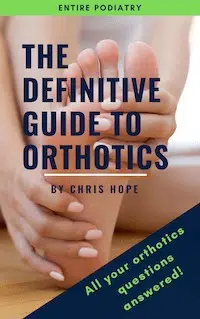Tibialis Posterior tendinopathy is a common condition that we treat at Entire Podiatry. It causes pain behind the back of the inner ankle which can extend down the inside of the foot along the arch.
Anatomy
Our calf is actually a group of muscles which all work together to help us to stand and walk. The muscle that is located most deeply in the calf is our Tibialis Posterior muscle. This muscle lies deep in the calf closest to our tibia and fibula bones. The muscle turns into a tendon at the lower inner calf above the ankle. This tendon passes behind the ankle bone (the medial malleolus) and attaches to the bones on the inside of the foot at the high point of the arch.
This muscle has an important job of supporting the arch of the foot. It is also an ‘invertor’ of the foot as it is responsible for rolling our foot outwards (supinating our foot). It also helps the other muscles in our calf with plantarflexing our foot which is the movement we use when we go onto the balls of our feet or when we ‘toe-off’ while walking so the heel can leave the ground.
Tibialis posterior tendinopathy usually arises from overuse. This condition is most often seen in people with ‘flat feet’ also known as a ‘pronated foot’. This is because the tibialis posterior muscle must work very hard in a flat foot to lift and support the arch and to prevent the inward collapse or roll of the feet. If not treated it can lead to a tear or rupture of the tendon.
Symptoms
Pain is usually felt behind the inside of the ankle. This pain can extend along the inside of the foot towards the arch. The pain is typically worse with activity and time spent on your feet. There may also be swelling around the ankle and the inside of the foot.
You may feel weaker on this foot compared to the non-affected foot. You might notice this weakness by assessing your ability to do ‘calf raises’. This involves rising up onto the ball of your foot and lowering yourself back down to your heels. The non-affected side may be able to do this movement with more strength and ease compared to the affected side.
If this condition has been present for some time, the affected foot may begin to change shape. This is known as Adult Acquired Flatfoot deformity. This occurs when the tibialis posterior tendon has been overloaded for some time and it begins to stretch and weaken and lose power. Because of this loss of power the tendon can no longer support the arch so the foot rolls and drops inwards. This is a progressive condition where the foot continues to become more and more pronated.
As the foot becomes flatter arthritic changes tend to develop affecting the subtalar, midtarsal and medial column joints. The arthritic changes cause additional pain and stiffness. In severe stages the ankle becomes misaligned which can cause stress fractures of the fibular.
Early identification and treatment of tibialis posterior tendinopathy is important to stop progression to adult acquired flatfoot deformity.
Treatment
It is important to have this condition properly diagnosed by your podiatrist to ensure that the treatment is appropriate for you. There are a few other conditions that present in a similar manner to tibialis posterior tendinopathy but the treatment will be different. Optimal treatment will also vary based on the duration and severity of the condition as well as your age, physical health and activity levels.
Treatment of the acute or the early stage of the condition involves a combination of:
- Rest from aggravating activities which cause pain
- Icing
- Anti-inflammatory medication
- Strapping – your podiatrist can show you how to strap your foot to help with tibialis posterior pain.
- Correct footwear- a supportive shoe that provides adequate support to the foot is vital to ensure quick healing. This condition will often worsen when patients wear very flat and unsupportive shoe and this encourages the foot to roll inwards which stretches and strains the tibialis posterior tendon.
In severe cases an immobilisation boot may be required in the short term. At Entire Podiatry we stock all sizes of immobilisation boots and can fit these to your foot.
Long-term management to allow the tendon to heal will involve a combination of strengthening exercises, changes to footwear and orthotics.
Exercises for tibialis posterior tendinopathy
Strengthening the muscle and tendon will be vital to managing pain and reducing the likelihood of this problem returning. However, exercising this tendon may not be appropriate at all stages of this condition. This is why it’s important that you work with your podiatrist to design an exercise program specifically for you and your needs.
- Your practitioner will design a program that gradually builds strength. This usually begins with a non-weight bearing protocol such as using an exercise band to restore the movement in the ankle and gently engage this muscle and tendon.
- If appropriate your practitioner may then progress to loading exercises such as calf raises (standing up on the balls of the foot and back down to the heels)
- Concentric and eccentric loading exercises of the tibialis posterior have also been shown to be very successful in the treatment of tibialis posterior tendinopathy:
-
- Have the patient stand on a raised platform (e.g. stair) with the inside of their foot hanging over the platform, this puts the foot into eversion, which eccentrically contracts the tib post muscle.
- The patient should then attempt to lift the inner aspect of the foot so that the inner border of the foot is bought up to the level of the platform. This inversion motion of the foot is concentrically contracting the post tib muscle.
Soft tissue therapy
Soft tissue therapy can be useful in the treatment of tibialis posterior tendinopathy. Podiatrist at Entire Podiatry can perform manual release of trigger point therapy. This can help to release tight muscles which can be contributing to the overload and dysfunction of this tendon.
Shockwave therapy
Shockwave is an exciting treatment modality available at some Entire Podiatry clinics. This treatment uses non-invasive high frequency shockwaves to stimulate repair of the injured tendon. Click here for more information on shockwave therapy.
A recently published case series in the Journal of Foot and Ankle Surgery looked at the success of shockwave therapy in the treatment of chronic tibialis posterior tendinopathy in patients who had been unresponsive to other forms of treatment.
This study found that a combination of radial shockwave therapy and foot exercises resulted in a clinically important improvements in 90% of patients in terms of improving their activities of daily living.
Shockwave therapy works by encouraging healing of the tendon in two ways:
-
New Blood Vessel Formation:
Shockwave therapy helps generate new blood vessels, a process called “neo-vascularisation”. The enriched blood flow helps provide the nutrients that assist with tendon healing.
-
Release of growth factors:
Growth factors are proteins that encourage the cells that repair tendon.
Orthotics
A pair of custom foot orthotics is highly effective in the treatment of tibialis posterior tendinopathy.
Your podiatrist will assess your foot function and structure to determine if you would benefit from a pair of custom foot orthotics.
The purpose of orthotics to manage tibialis posterior tendinopathy is to support the arch of the foot and to reduce tension on this tendon. This improves the alignment of the foot and reduces the load through the injured tendon.
Not only is this a very effective way to reduce the pain and the symptoms but also to prevent re-occurrence of the problem by reducing progressive flattening of the feet.
Click here for more information about custom foot orthotics.




